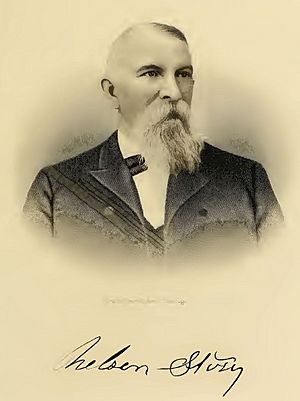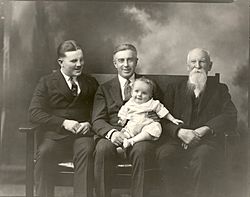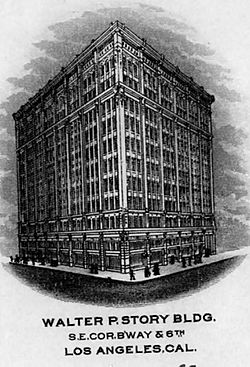Nelson Story facts for kids
Nelson Story Sr. (born April 4, 1838 – died March 10, 1926) was an important pioneer in Montana. He was a successful cattle rancher, miner, and businessman. He is famous for leading the first big cattle drive from Texas to Montana in 1866. He brought about 1000 Texas Longhorn cattle along the Bozeman Trail.
Nelson Story became the first millionaire in Bozeman, Montana, thanks to his many successful businesses. In 1893, he helped start the Agricultural College of the State of Montana by donating land. He also built two important homes in Bozeman, known as the Story Mansions. Later in his life, he became a successful real estate developer in Los Angeles, California.
Contents
Early Life and Adventures
Nelson Story Sr. was born in Burlingham, Ohio, in 1838. He was the youngest son of Ira and Hannah Story. Sadly, by the time he was 18, Nelson had lost both of his parents.
He worked as a teacher and studied at Ohio University. Then, he traveled west to Fort Leavenworth, Kansas Territory. There, he became a "bullwhacker," which was someone who drove teams of oxen pulling freight wagons. By 1862, he was a very successful freight driver in Denver, Colorado. In 1862, he met and married Ellen Trent in Kansas. In 1863, Nelson and Ellen moved to Montana. They arrived in Virginia City, Montana in June 1863, right after a big gold discovery.
Montana Gold Fields
Nelson Story found a gold field near Alder Gulch, Montana that he thought still had a lot of gold. He started working there and, in just a few months, he found $30,000 worth of gold. He turned this gold into $20,000 in cash. This money became the starting fund for his famous cattle drive from Texas to Montana.
The Great Cattle Drive of 1866
In 1866, Nelson Story went to Texas and bought 1000 Longhorn cattle for $10,000. This was right after the American Civil War, and the economy in Texas was struggling. However, there were many cattle available for very little money. People in the northern states needed beef, and they had money to pay for it.
Many former soldiers became cowboys to drive cattle north. About 260,000 cattle were driven north that summer. They were headed for Sedalia, Missouri, where they could be shipped by train. To get there, the cattle had to pass through what is now Oklahoma, which was then Indian Territory. Native American tribes there charged a fee for the cattle to pass through their lands. Story paid this fee.
When Story reached Baxter Springs, Kansas, he faced another challenge. Armed groups, known as Jayhawkers, were stopping cattle drives. They demanded money to let the cattle continue. Story refused to pay. Instead, he found a different, longer route through Indian Territory to avoid them.
Nelson Story then decided to try for Montana, where gold miners would pay high prices for beef. He became part of the first cattle drive ever to use the Bozeman Trail. He bravely led his herd north. At Fort Phil Kearny, the U.S. Army told Story to stop because of conflicts with Sioux warriors. But Story ignored the order and continued his journey into Montana. He and his drovers even fought with Sioux warriors along the way. Only one drover was killed.
Story and his cattle arrived near Livingston, Montana, in December 1866. They set up winter camp there. Nelson Story became a very successful cattle rancher. For at least two years, he bought and sold cattle to hungry miners for up to ten times what he paid for them in Texas. By 1870, Story's ranch in the Paradise Valley was the biggest cattle operation in the northern plains. Some people believe Story named the beautiful Paradise Valley himself. This cattle drive inspired the famous novel Lonesome Dove.
Life in Bozeman, Montana
Nelson Story settled his family in Bozeman. He used his business skills and his cattle fortune to start other ventures. He got involved in banking, general stores, and grain businesses. In 1882, he helped start one of the first banks in the area, the Gallatin Valley National Bank. However, this bank closed during a financial crisis in 1893.
In 1882, Story also opened the Story Flour Mill. This mill produced a lot of flour every day. It was a main supplier for the U.S. Army at Fort Ellis and for the Crow Indian Reservation. His many successful businesses made him Bozeman's first millionaire. Nelson Story was also a founding member of the Society of Montana Pioneers.
Los Angeles, California
Nelson and Ellen Story had a son named Walter Perry Story, who was born in Bozeman in 1882. Walter went to military school and then business college. He worked with his father in Bozeman for a few years. In 1905, Walter moved to Los Angeles. There, he worked in real estate and started the first motor transit line in the western United States.
Walter then helped his father expand their businesses in Los Angeles. They built the Story Building, a twelve-story skyscraper, which was finished in 1910. After this, Nelson Story retired and moved back to Bozeman. However, he passed away in Los Angeles on March 10, 1926.
Walter Perry Story later served in the military during World War I. He became a Brigadier General in the California National Guard. He also founded Camp Merriam, which is now known as Camp San Luis Obispo.
Nelson Story's Legacy
Nelson and Ellen Story had seven children, and four of them lived to adulthood. Their son, Nelson Jr. (1874–1932), became the mayor of Bozeman and later the Lieutenant Governor of Montana. Thomas Byron Story (1876–1954) became a well-known merchant in Bozeman. Walter P. Story (1882–1957) became a successful businessman in Los Angeles and a decorated Major General.
The Walter P. Story Building (built in 1909) in Los Angeles was a gift from Nelson Story to his son Walter. It was one of the first skyscrapers in Los Angeles and is still standing today. Nelson Story's great-great grandson, Mike Story, still runs the Story Ranch and Cattle Company in Paradise Valley, Montana.
In 1893, Nelson Story donated 160 acres (65 hectares) of land for an agricultural college. This college grew into Montana State University.
In 1919, Nelson Jr. and T. Byron Story paid for the building of the Ellen Theater in Bozeman. They named it to honor their mother, Ellen. The theater is still used today.
In 1959, Nelson Story was recognized for his achievements and inducted into the Hall of Great Westerners. In 2008, he was also inducted into the Montana Cowboy Hall of Fame. Nelson and Ellen Story are buried together in Sunset Hills Cemetery in Bozeman, Montana.
Images for kids






